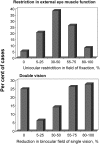Incidence and clinical presentation of moderate to severe graves' orbitopathy in a Danish population before and after iodine fortification of salt
- PMID: 22518849
- PMCID: PMC3387399
- DOI: 10.1210/jc.2012-1275
Incidence and clinical presentation of moderate to severe graves' orbitopathy in a Danish population before and after iodine fortification of salt
Abstract
Context: Population-based data on the incidence and clinical presentation of moderate to severe Graves' orbitopathy (GO) are scarce, and virtually nothing is known on the effect of an iodization program on the incidence and presentation of GO.
Objective: The objective of the study was to characterize incident moderate to severe GO in North Jutland County, Denmark, during the period 1992-2009, before and after the Danish salt iodization program.
Design and patients: The design of the study was a prospective register of patients with incident moderate to severe GO in a population during 8.9 million persons × years of observation.
Setting: The study was conducted at a thyroid-eye clinic of university hospital.
Main outcome measures: Clinical presentation and incidence before and after the year 2000 initiation of the mandatory Danish iodization of salt were measured. The incidence of GO was related to the incidence of Graves' hyperthyroidism (GH) in the same population.
Results: The incidence rate of moderate to severe GO was 16.1/million per year (women: 26.7; men: 5.4), with no change associated with iodization of salt. The moderate to severe GO incidence was 4.9% of the incidence of GH. The incidence rate ratio between women and men with GO (4.9) was not different from the ratio in GH. Compared with GH, only a few patients (<2%) suffered from moderate and severe GO below the age of 40 yr, whereas GO was relatively common in age groups 40-60 yr (∼8%).
Conclusions: Approximately 5% of the patients with Graves' disease develop moderate to severe GO, with a similar risk in women and men with Graves' disease. The risk of GO is much higher in patients aged 40-60 yr than in young patients with Graves' disease. Salt iodization was not associated with a change in the incidence of GO.
Figures





References
-
- Wiersinga WM. 2011. Autoimmunity in Graves' ophthalmopathy: the result of an unfortunate marriage between TSH receptors and IGF-1 receptors? J Clin Endocrinol Metab 96:2386–2394 - PubMed
-
- Abraham-Nordling M, Byström K, Töring O, Lantz M, Berg G, Calissendorff J, Nyström HF, Jansson S, Jörneskog G, Karlsson FA, Nyström E, Ohrling H, Orn T, Hallengren B, Wallin G. 2011. Incidence of hyperthyroidism in Sweden. Eur J Endocrinol 165:899–905 - PubMed
-
- Bartalena L, Baldeschi L, Dickinson A, Eckstein A, Kendall-Taylor P, Marcocci C, Mourits M, Perros P, Boboridis K, Boschi A, Currò N, Daumerie C, Kahaly GJ, Krassas GE, Lane CM, Lazarus JH, Marinò M, Nardi M, Neoh C, Orgiazzi J, Pearce S, Pinchera A, Pitz S, Salvi M, Sivelli P, Stahl M, von Arx G, Wiersinga WM. 2008. Consensus statement of the European Group on Graves' orbitopathy (EUGOGO) on management of GO. Eur J Endocrinol 158:273–285 - PubMed
-
- Wiersinga WM, Prummel MF, Terwee CB. 2004. Effects of Graves' ophthalmopathy on quality of life. J Endocrinol Invest 27:259–264 - PubMed
Publication types
MeSH terms
Substances
LinkOut - more resources
Full Text Sources
Other Literature Sources
Medical

